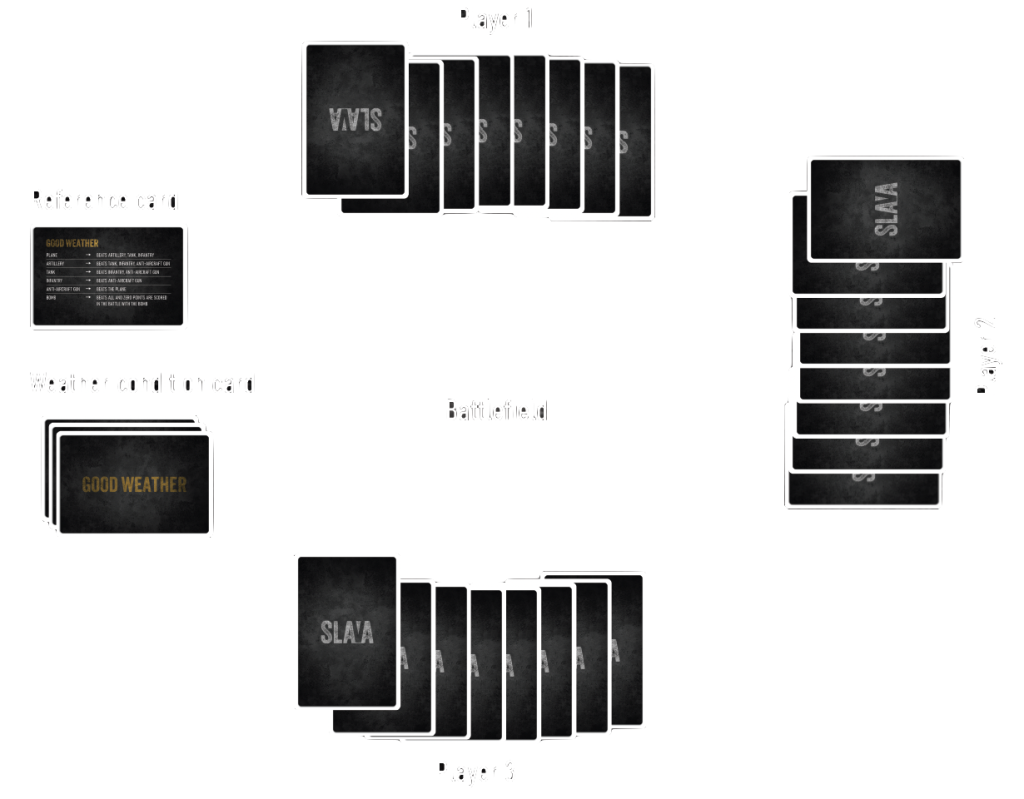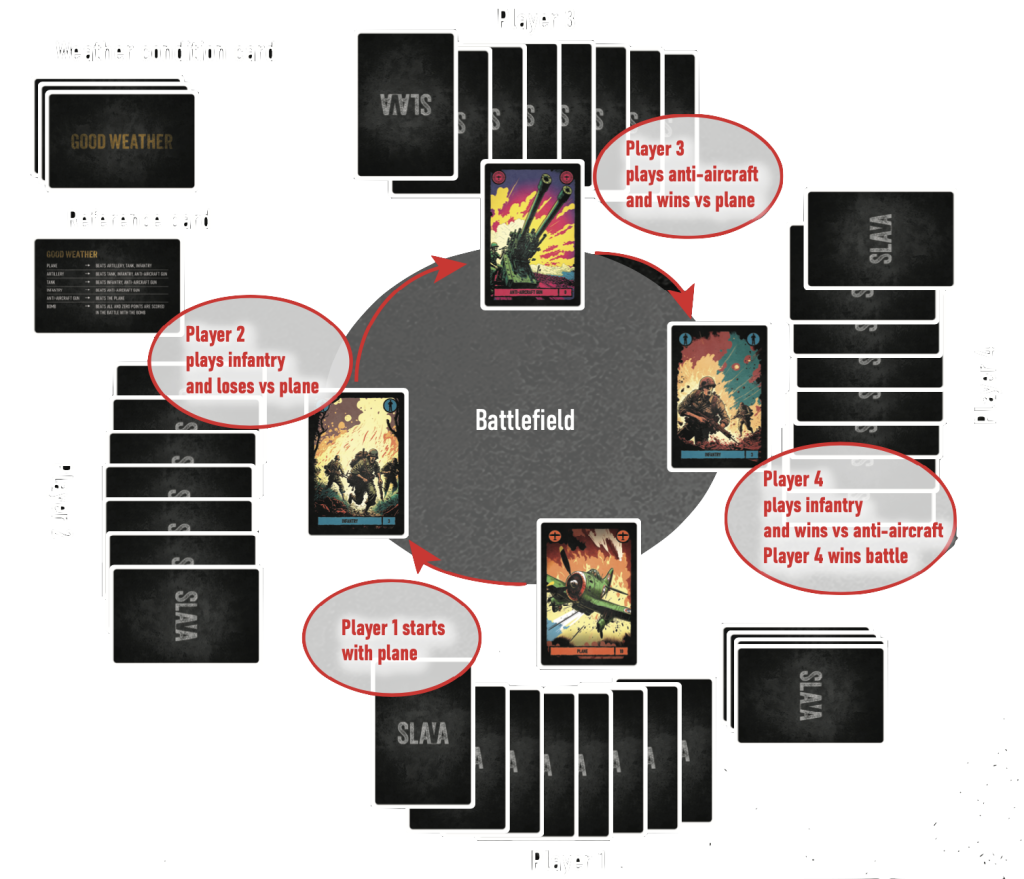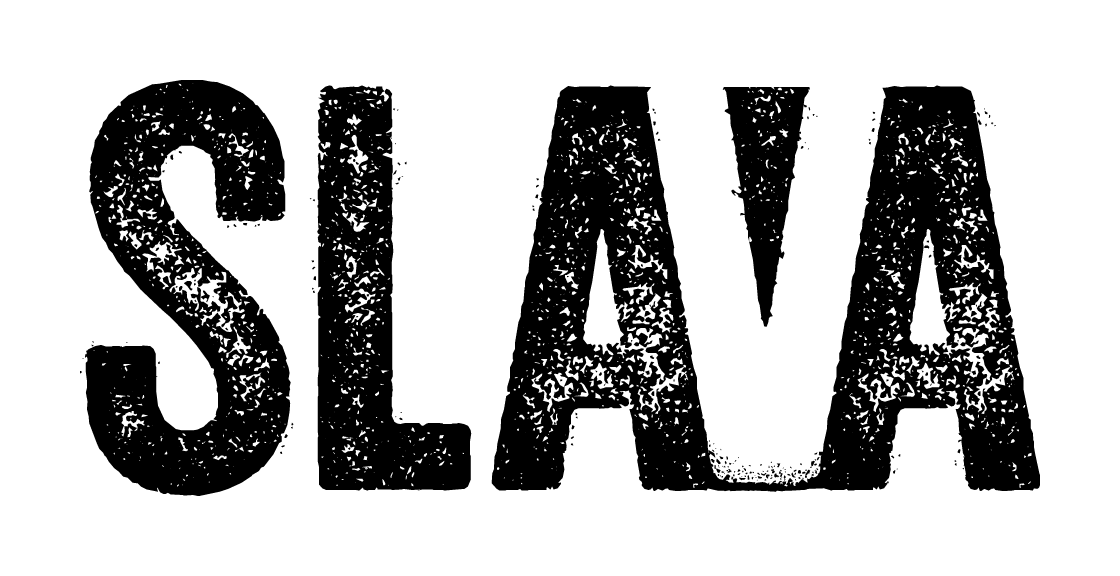RULEBOOK
TABLE OF CONTENT
(click to skip to section)
INTRODUCTION
Welcome to Slava!
In this awesome game, you’ll use your wit and skill to outsmart your opponents or to sabotage your friends. Do you have what it takes to win the war?
The first player to win 5 campaigns wins the war and therefore, the game!
A typical game of Slava takes approximately 25-50 minutes to complete.
WHAT’S IN THE BOX
Inside this box, besides this guide, you’ll find the following components:



HOW TO START
Depending on the number of players, you first select the cards for play. Make sure that you always add all the commander cards for each type of unit. (Only the bomb has no commander) These are the cards with the commander symbol. Select your cards depending on the number of players:
- 2-player game: You select 3 planes, 3 artillery, 3 anti-armor units, 6 tanks, 6 infantry, 2 anti-aircraft guns, and the bomb.
- 3-player game: You select 3 planes, 3 artillery, 3 anti-armor units, 6 tanks, 6 infantry, 2 anti-aircraft guns, and the bomb.
- 4-player game: You select 4 planes, 4 artillery, 4 anti-armor units, 8 tanks, 8 infantry, 3 anti-aircraft guns, and the bomb.
- 5-player game: You select 5 planes, 5 artillery, 5 anti-armor units, 10 tanks, 10 infantry, 4 anti-aircraft guns, and the bomb.

Next, shuffle your selection of cards and deal 8 cards to each player. Then shuffle the five weather cards and place them face down as a separate pile on the side of the playing field on the table. And finally, place the 2 reference cards next to the weather condition card pile.
SETUP

Now you’re ready to play Slava! Whoever has watched the movie Saving Private Ryan most recently goes first. In case of a tie or unfamiliarity with the movie, the oldest player goes first.
HOW TO PLAY
First, you turn over the top card from the weather pile. This indicates if you have clear skies, or a storm and heavy fog brewing. These weather conditions create different dynamics and influence the strength of each card. The weather condition, however, does not affect the points of a card, the points are always the same! The following points table shows the points of each type of card:
Points table:
Plane – 10 points
Artillery – 7 points
Tank – 5 points
Anti-armor unit – 3 points
Infantry – 3 points
Anti-aircraft gun – 0 points
Bomb – 0 points
Good Weather Condition Reference:
Plane –> beats anti-armor unit, artillery, tank , infantry
Anti-armor unit –> beats artillery, tank, anti-aircraft gun
Artillery –> beats tank, infantry, anti-aircraft gun
Tank –> beats infantry, anti-aircraft gun
Infantry –> beats anti-armor unit, anti-aircraft gun
Anti-aircraft gun –> beats the plane
Bomb –> beats all, but makes that zero points are scored in the battle with the bomb
With bad weather condition we have different results!
Bad Weather Condition Reference:
Infantry –> beats plane, anti-armor unit, artillery, tank, anti-aircraft gun
Anti-armor –> beats the plane, artillery, tank, anti-aircraft gun
Tank –> beats the plane, artillery, anti-aircraft gun
Artillery –> beats the plane, anti-aircraft gun
Anti-aircraft gun –> keeps beating just the plane
Plane –> no take-off so sees nothing, beats nothing
Bomb –> beats all, but makes that zero points are scored in the battle with the bomb
Now we know all the points belonging to each type of card and weather-related differences, it’s time to start playing.
So, you just turned over the first weather card and know the weather condition. First variant: This type of weather remains there for one campaign (1 campaign = 8 battles = everyone has played all 8 cards from their hands). And after each campaign, the weather cards are shuffled again!
Second variant: This type of weather remains there for 4 battles after which another weather card is flipped from the remaining weather card pile. And this weather applies to the last 4 battles.
Place the reference cards on the table in case you have forgotten which card beats the other.
LET’S START!
After determining with the Saving-Private-Ryan rule which player goes first, players shuffle the military cards for each campaign. Shuffling the cards for each campaign is done clockwise. The player sitting left from the player who shuffled begins.
Players take turns clockwise. Each round is a battle, in which each player plays one card. By playing a card, a confrontation is resolved. At the end of each battle, the last man standing wins the battle and takes all the cards of that battle. The winning player of a battle has to start the next battle.
A campaign is finished after 8 battles have been completed. (1 campaign = 8 battles) The player who has earned the most points after one campaign, receives a victory point.
So how do you win a battle? You use the weather-related strength to determine who wins. Important is that the last played card of the same type (e.g., infantry and next player also plays infantry) beats the identical card when a confrontation is resolved! The commander card is the exception and cannot be beaten by cards of the same type.
BATTLE EXAMPLES
Battle example 3-player game
It’s a 3-player game. The weather is good during this campaign. The first battle of the campaign is commencing.
The first player plays the tank commander. The second player also plays a tank. The first confrontation has immediately been resolved and the first player’s tank commander wins. Next, the third player plays a plane. Now it’s the first player vs. the third player who wins by playing a plane. he third player wins the first battle with a total of two tanks and a plane card. According to the points table, this player has earned 20 points (2 tanks = 2×5 points, 1 plane = 1×10 points). (You don’t have to add up these numbers yet. Do this at the end of a campaign.) The third player now places these 3 cards face down in front of him. And no looking back at cards by any player. Then, the second battle starts.
Battle example 4-player game
It’s a 4-player game. Clear skies during this campaign. The second battle of the campaign is commencing.
The player that won the previous battle starts with a plane. The second player plays infantry and therefore loses the first confrontation. The third player plays an anti-aircraft gun which beats the plane. This is followed by the fourth player who plays an anti-armor unit which beats the remaining anti-aircraft gun and crew. The fourth player wins the battle and wins 16 points which are put face down in front of him. Then, the third battle begins.

IMPORTANT TERMS!
Before we run through the last battle example there a few more rules to remember!
- Last battle win | If you win the last (8th) battle of a campaign you receive an additional 10 points.
- Playing the bomb | Playing the bomb will nullify all points of that battle. If you have played the bomb you have to start the next battle unless the bomb was played during last battle of the campaign.
- Bomb in last battle | If you have the bomb and play it in the last (8th) battle of the campaign, you will still nullify all points of that battle, however, you will get a 10-point penalty for not using the bomb earlier. Also, the 10-point bonus of winning the last round does not apply. These 10 points will be deducted from the player that played the bomb for this campaign. In all other battles, the first seven, this penalty does not apply.
- Three of a kind penalty, knocking| If three of the same type cards are played in the same battle and someone knocks, a 20-point penalty will be awarded to the player who played the third identical type of card. It does not matter if the same type cards are played after each other or if other cards have been played in between. If nobody knocks during the battle, no points can be deducted retrospectively. Also, no points are deducted in if someone knocks in the battle with the bomb. The penalty or penalties for knocking are deducted at the end of a campaign.
- Play any card you like | You are allowed to not top a card. So, there is no mandatory winning of confrontations in the battles, even if you have the cards that could do it. Therefore, you can always play any card from your hand.
- Start of campaign | Shuffling and the person who begins each campaign keeps rotating clockwise. The person left of the person that shuffles is allowed to begin. You only apply this rule at the beginning of the first campaign: whoever has watched Saving Private Ryan most recently or the oldest player starts.
- Equal campaign points | When a campaign ends in a tie for two (or more) players, they all receive a victory point. Even if that means they all win the game.
- No looking back | Finished battles are always stacked horizontally, face down, in front of the player who won that battle. No one is allowed to look back after the battle once the cards have been placed face down.
- Same type card win and commander | Important is that the last played card of the same type (e.g., infantry and next player also plays infantry) beats the identical card when a confrontation is resolved! The commander card is the exception and cannot be beaten by cards of the same type.
ONE MORE BATTLE EXAMPLE (5-PLAYER)
One more battle example and you’re good to go!
It’s a 5-player game. The weather is bad during this campaign. The 8th and therefore last battle of the campaign is commencing.
All players now only have one card remaining in their hands. The player that won the previous battle starts with a tank. The second player also plays a tank and therefore the second player wins this confrontation. The third player now plays infantry which beats the second player’s tank in bad weather. The fourth player also has a tank left and plays it. The third player with the infantry card is still in a winning position. However, there are now three of the same type of cards on the table and therefore the first player quickly knocks on the table to claim the penalty of 20-points for the fourth player who played the third tank. The fifth and final player plays the bomb. This nullifies all points of the round. Including the claimed 20-point penalty for knocking three of a kind and the 10 points you get for winning the last round. So, no points are awarded to anyone at the end of this battle. In addition, player number 5 has to deduct 10 points from his total because he played the bomb during the last round. Since playing the bomb in the last round always leads to a penalty.
Since it was the 8th and final battle of the campaign, all players add up the points from the battles of this campaign. All players that received a penalty in the first 7 battles deduct this from their total as well. And player number 5 deducts 10 points from his total for playing the bomb in the last round. After adding up (and deducting) all points per player in this campaign there will be a player with the highest amount of points. And this player will receive a victory point. If this is the player’s 5th victory point, he wins the game. If not, the main cards will be shuffled again and will be equally divided among the players. The weather deck will also be shuffled for the next campaign and you are ready to go again.
HOW TO WIN
There is one way to win the game and that’s by getting 5 victory points! So, whoever wins 5 campaigns first, wins the game.
2-PLAYER GAME
2-player game: You select 3 planes, 3 artillery, 3 anti-armor units, 6 tanks, 6 infantry, 2 anti-aircraft guns, and the bomb. And, as always, make sure all commanders are in there as well.
As you might have noticed the 2 and 3-player game is identical in terms of cards. This is because the third player in a 2-player game is the infamous ‘Deckie’, who serves as an automated third player. In a 2-player game, deal the cards as if there were three players. The pile that does not belong to an actual player belongs to Deckie. The deck played by Deckie is face down on the table and for each battle you draw the top card.
Example 2-player game:
It’s a 2-player game. This campaign is blessed with clear skies. The third battle of the campaign is commencing.
The player that won the previous battle starts with a plane. The second player, which is ‘Deckie’ in this case, plays an anti-aircraft gun (turn over the first card of Deckie’s deck.) and therefore wins the first confrontation. Now the third player plays infantry which beats the remaining anti-aircraft gun and crew. The third player wins the battle with 13 points and places the cards face down in front of him. Then, the fourth battle begins.
2-VS-2-PLAYER GAME
There is also an amazing 2-versus-2-player game mode which is played a lot in the community.
You can use the same setup as a regular 4-player game. However, this time your companion is sitting across from you. So, you select 4 planes, 4 artillery, 4 anti-armor units, 8 tanks, 9 infantry, 3 anti-aircraft guns, and the bomb. Also, include all commander cards.
The rules remain the same as the regular game, however, you add up the total amount of points of each duo to see who has won a campaign. The duo that earns 5 victory points first wins!
The average playtime for the 2-versus-2-player game is 20-45 minutes but you can extend the number of victory points and consequently playtime according to your own wishes.
Important notice: You are not allowed to show, or state, your cards to other players. Also, you cannot try to influence your companion by signaling!


